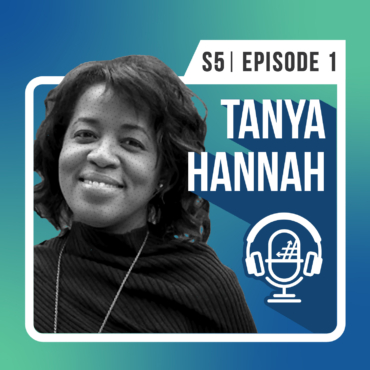S5 E1: Making Services Safer in King County, Wash.

Although most of us don’t look forward to paying a utility bill or submitting a service request, it’s great to know that our government is keeping user experience and safety in mind, especially during the pandemic.
In this episode, we’ll learn how King County Washington is making basic services simpler and safer by going digital. With Tanya Hannah, the county’s Chief Information Officer, let’s explore how familiar tools such as chat bots and Microsoft Teams have successfully enabled remote work for 15,000 employees to make sure the county’s critical needs are met.
The forward-thinking approach of Tanya’s team could benefit any business exploring digital transformation.
In this episode:
Tanya’s background
Growing up back in Philadelphia, there were three things that inspired me to pursue a career in tech. First, I had an amazing teacher that inspired science and technology. Because of that, I decided to do a summer program at the University of Pennsylvania, which was a STEM program, and it was to introduce persons of color to careers and technology. I just had a great time, went to college, and the rest is history.
I actually started off in the private sector. I came up through the ranks work—I did help desk, infrastructure management, went into service delivery, application delivery, software engineering. My career has went through a number of critical areas, which are now particularly helpful to me as CIO, as I can better understand all facets of the business. This is my first government technology role, so it’s been an interesting ride to say the least.
Overcoming challenges as an African-American woman
Being a woman and a person of color, rarely was I ever with a team that had another woman. But what I found though, is that some of the males that helped me in my career loved how I always brought a customer-focused perspective. I could provide a different insight, not only about the data, but also with regards to what it means to build a better product and to offer services in new ways.
People are all different, and so having different perspectives brings more vitality and growth to teams.
King County as the land of tech companies
King County is the headquarters for 10 of the most recognizable brands in the world. The thing that strikes me the most about these tech companies that are headquartered here is the fact that they are known for customer service; for understanding customers. What drives them? How do you engage with your customers? How do you build a long-term relationship? I think that model is certainly something that all companies or organizations should really study as a use case.
Being here within King County, the bar is set really high. And it is always imperative that we continue to raise the bar with innovation and with how we provide service to customers.
So with that, it is easy to do business with the government. We don’t make it this huge burden, and that’s where technology is good because it enables us to do things. Pandemic hits, the government cannot shut down—we just keep on going and technology enables it. And it’s been a fascinating experience.
Improving technology in government
Being here in this region, I would put my team King County Information Technology above most public and private sector companies in the world. They are totally amazing. People think the government doesn’t address their needs, but I can tell you, we use augmented and virtual reality. We use AI, machine learning, digital assistance. We’re doing all of it and we’re doing it well. It takes us a little bit longer to do things, but we certainly get it done.
And because we have over 2.2 million residents here that we serve, it is imperative for us to really think about technology and how we utilize it to enable our operations. The 64 lines of business that I support—whether it’s public health and the pandemic, transportation and buses out on the road or water taxi—are all driven by technology.
And so, we are continually thinking about the ways that we can improve technology in government. Yes, we are slower than you might find in the private sector, but we’ve been able to keep our funding steady to help us be able to innovate and deliver new products and services out to the public. As we’re retiring some of our legacy systems, it will get easier for us to deliver faster.
When COVID hit
Initially with the pandemic, we saw that the public, the media, and other jurisdictions were looking to King County as ground zero for information. People were very interested in our public dashboards on what was happening at long-term care facilities. Externally facing, that was something that we needed to work on. Internally, we were standing up sites and field hospitals to handle quarantine and assessment for COVID. We were building bed availability chatbots to serve the public.
Those things naturally occurred at the moment because we’ve got to deliver. At the same time, we were rolling out solutions and transitioning employees to telework. And we just did these things seamlessly because the thought was, What do we need to do to help our customers? To have a longer-term impact on government, what should digital transformation look like?
Forwarding innovation and digital transformation
Even before the pandemic, we were already thinking about the future of work. But with the pandemic, we saw how the future of work is here, and it is more than just video calls—it is about reimagining services in new ways.
For example, even before the pandemic, we were preparing to do more virtual courts, putting in video conferencing and things like that. But now in the pandemic, we’re utilizing Microsoft Teams to share evidence amongst people. We’re on video between Teams and Zoom. We are doing things that even I probably wouldn’t have imagined eight months ago ahead of COVID.
We’re also working on scheduling people so that folks wouldn’t have to come downtown into a government office for their parking and tracking tickets. We are moving all that online to be delivered virtually. Now we can offer services and make it more convenient, leveraging technology with video. I think it’s going to be fascinating. And I venture to guess that the government is probably going to be more innovative than the private sector because it will have to be.
Government as a marketplace strategy
I believe the government is very similar to retail. Individuals come in to you for services and information, and it’s your job to provide whatever that service is. We are talking about a government marketplace that allows you to really think about automation.
Automation isn’t a point-to-point solution—you have to think to the end. How do I take out all of the friction points in every step of the way to make it extremely seamless, where I can just find what I need or perform a task and not do things in a convoluted way?
Think about how your customer would experience it, whether they’re in person, online, finding you via the web—how are you going to help them get what they need in such a way that it’s delivered seamlessly and efficiently? How do you do it in such a way that when the individual or the business has completed their engagement with you, they want to come back? So, I think that’s where we’re going to see government and innovation flourish.
Security and collaboration
When it comes to staying compliant, we do have dedicated security professionals handling security, and we certainly utilize technology. There are vendors everywhere to help, so you have to manage your vulnerabilities. As best as you can, think about how to prevent unauthorized access to your data and your systems, because the threat vectors are constantly evolving.
On the collaboration side and providing tools to the 15,000 employees we support, Teams certainly provides an experience where you can create your channels, look at your files, look at chat conversations, schedule your meetings, and things like that. The Microsoft 365 suite just allows you to have a mobile workforce, and I believe collaboration tools are going to continue to grow.
I think the biggest challenge though is, we can always get technology overload. Because there’s just so much change coming at us. So, it’s going to be interesting how we navigate that little fine line. There’s going to be this rebalancing of our work-life balance.
Making #ShiftHappen
I would say, go big or go home. In government, there is no lack of opportunities to do things better than you could have ever done before. To really see innovation and help the communities we serve or the employees that we support, you’ve got to think big.
Today’s takeaway from Tanya:
“For me, it’s about what’s next. IT is out there powering cities, counties, and states. With such an integral part in people’s lives, how are we going to utilize our platforms to make shift happen?”
Subscribe where you get your podcasts! Search for “#ShiftHappens” in your favorite podcast app.
With over 20 years of business and technology experience, Dux has driven organizational transformations worldwide with his ability to simplify complex ideas and deliver relevant solutions. He serves as the Chief Brand Officer of AvePoint who has authored the LinkedIn Learning course How to Build Your Personal Brand, the book SharePoint for Project Management, as well as numerous whitepapers and articles. As a public speaker, Dux has delivered engaging, interactive presentations to more than 25,000 people at leading industry events around the world. He also hosts the modern workplace podcast #shifthappens that focuses on how leading organizations navigated their business transformation journey. Dux advocates tirelessly for inclusion, using technology for good, and philanthropic initiatives. Connect with him: http://dux.sy



